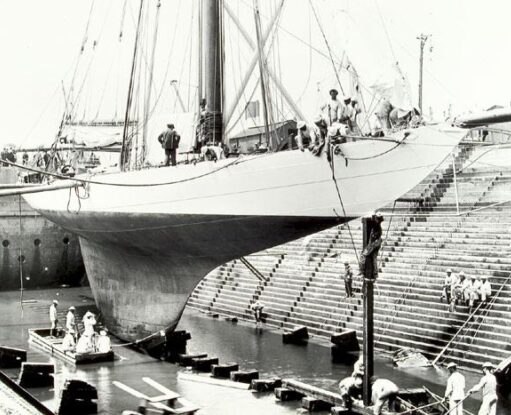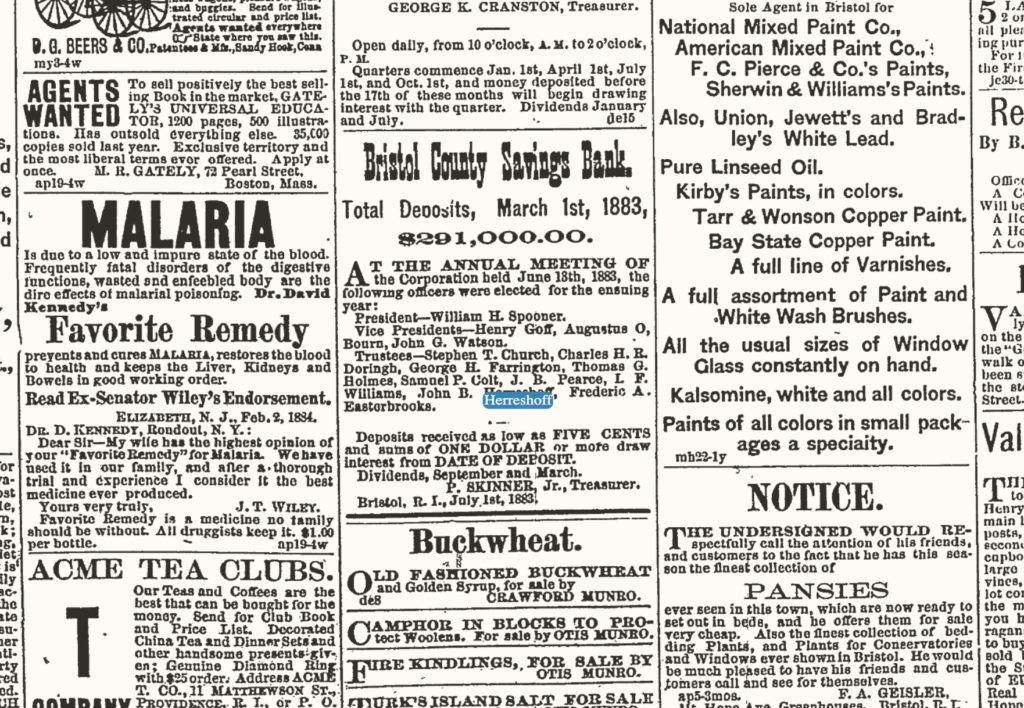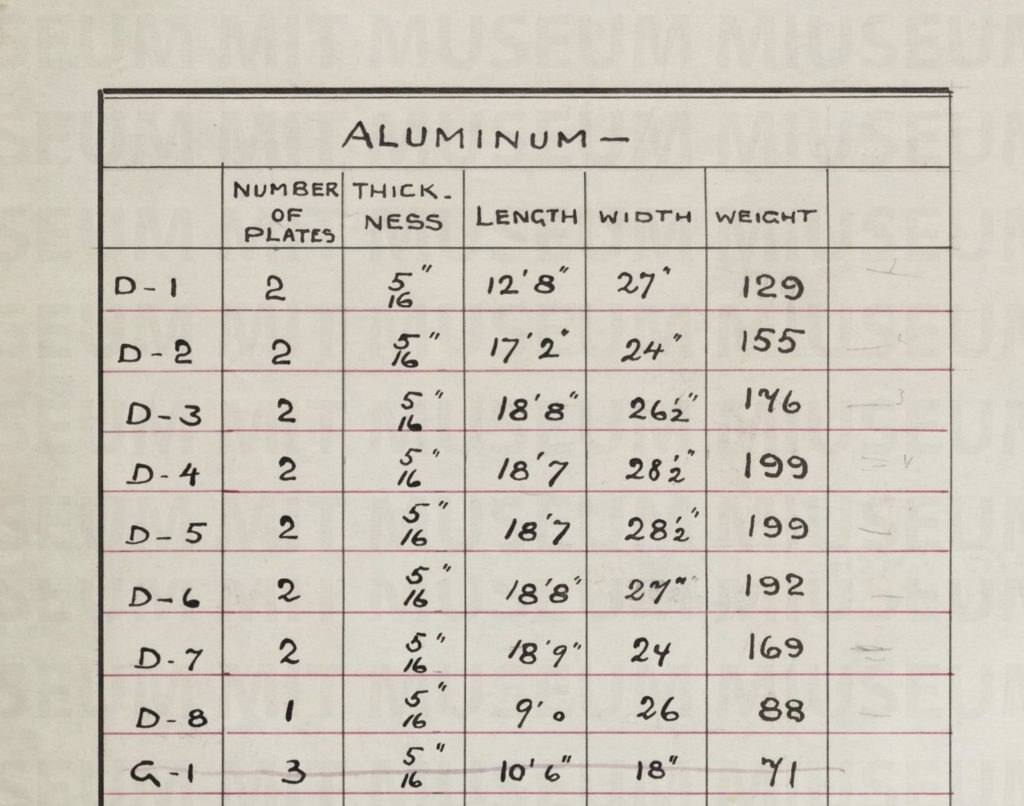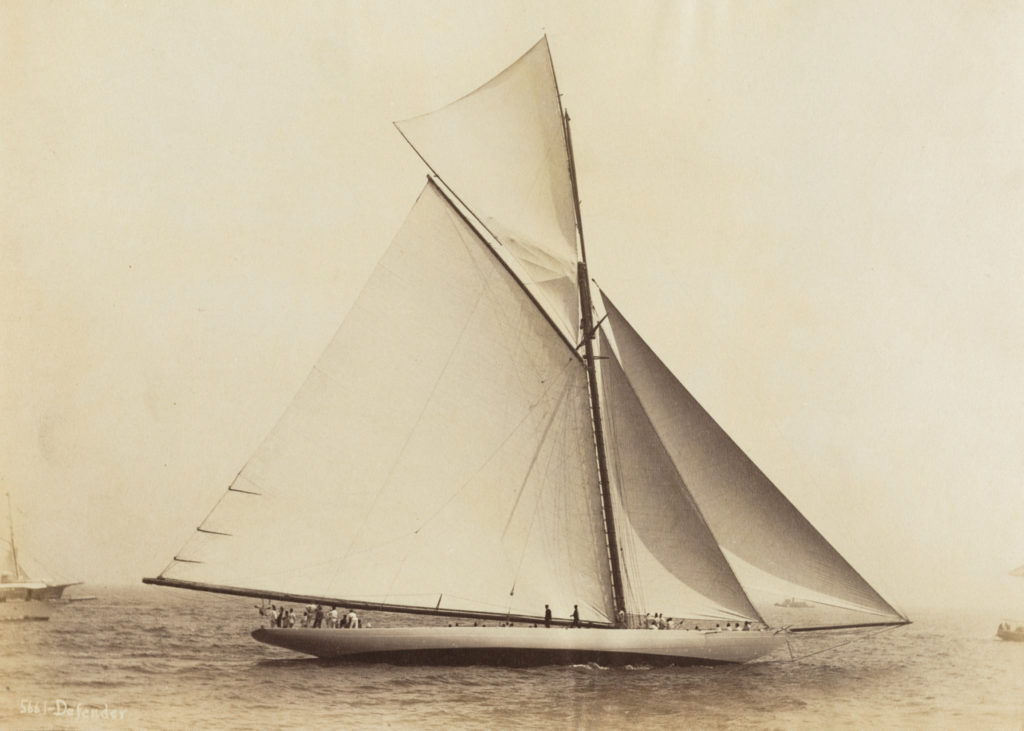May 11, 2020
This Week in Herreshoff History: May 11
Town Council duties and poorly placed gas street lamps, rumors of yachts and Cup Defenders, and the surprising cost of aluminum

May 10, 1884
The name "Herreshoff" is mentioned twice in various activities around town. Though not directly connected to HMCo. operations, it's and an interesting indication of the family's participation in civic activities within the local community, which are regularly reported on in the Phoenix. It is hard to imagine how they could find the time considering the considerable output and activity at HMCo., and yet they took active roles on Town Council and as officers of the Bristol County Savings Bank, and concerned themselves with such vital issues as chairing committees dedicated to the correction of poorly placed gas street lights...!

May 12, 1894
Rumors in the Bristol Phoenix speculate at a visit to the shops by George J . Gould, "one of the owners of the crack yacht VIGILANT [HMCo. #437, and 1893 America’s Cup Defender], champion of last seasons racers, —accompanied by Capt. Hank Haff..." but the Herreshoffs are closed-lipped on the matter as ever. Is it a new commission? Could it be something in connection with VIGILANT? Only time would tell! Irrespective of Gould's involvement, the rumors of another Cup Defender would prove out eight months later with another signed contract in January of 1895 (see below)...
May 10, 1895
This article about the aptly named America's Cup Defender, DEFENDER (HMCo. #452) in the Bristol Phoenix was reprinted from the Providence Sunday Journal on May 10, 1895. We enjoyed this article so much that we have followed suit and reprinted the full text below. (The ads in the 1895 Bristol Phoenix front page still make taking a look at the original scan more than worthwhile, if you have the time).

The emphasis on the high value of aluminum in this piece provides us with a fascinating snapshot of a very particular moment in time: in the mid 1800s, aluminum was more valuable than precious metals like gold and silver, and was used only in small quantities for things like jewelry and cutlery because it was so difficult (and therefore expensive) to extract and refine. Production improvements decreased the cost slightly through the second half of the 19th century but even as late as 1884, aluminum produced in the U.S. was still $16 per pound - not a whole lot cheaper than silver at $19 per pound. When the Washington Monument was topped with a 9" tall, 100 ounce aluminum pyramid in 1884, that tiny pyramid was the largest piece of aluminum that had ever been cast at that date! So it is impressive to consider that just over a decade later, production practices in the U.S. had ramped up enough to provide the 123' LOA DEFENDER with deck beams, topside plating and deck plating (granted rolling is a different production process than casting... but still!) . It came with a steep price tag of course - the Tobin bronze and steel Cup Defender VIGILANT (HMCo. #437) cost $55,000.00 just two years before in 1893, compared to the aluminum and manganese bronze DEFENDER's staggering price of $98,050.00 in 1895.

DEFENDER proved fast and able and lived up to her name, but the inherent vice in her construction would rapidly lead to her self-destruction. The use of aluminum was still novel in boats and the combination of bronze, aluminum and salt water was problematic, essentially creating a battery and dissolving the aluminum plating even underneath the paint. DEFENDER was scrapped in 1901, just six years after launch. Given the materials used in her construction and the fact that she was laid up for three seasons in the water, it is actually remarkable she lasted as long as she did. No one could argue that DEFENDER's excellent performance in the Cup defense still came at great literal and figurative cost, and today we perceive her as part of the Cup's high-speed trajectory towards the single-use, "unwholesome" racing machines (much maligned by the yachting press) that culminated with HMCo.'s triumphant winning monster - RELIANCE (HMCo. #605)!
B R I S T O L Y A C H T I N G N O T E S
What Is Being: Done In the Local Boat Yards
The Sunday Journal gives the following yachting news, of interest to Bristol readers:
The spars of the cup defender, including the main mast, topmast, main boom, gaff and spinnaker boom, arrived by rail at Bristol from Boston Saturday afternoon on three flat cars, They are all fine looking spars and very heavy. They were moved to the works this week. The deck beams of Defender, that arrived at the works a few days ago, are made of as pure aluminum as possible, barring a small amount of sodium of potash for the purpose of preventing corrosion. Several of these deck beams have been bent to the required shape for the deck on the bending tables and the ends fitted for bolting to the frames. From present indications it would seem that the 'aluminum plates will be painted, and preparations for that purpose have already been begun.
A number of riveters arrived Friday, home from the Bath Iron Works, and they expect to be taken on for work on the Defender the coming week. It is understood from these men that a large number of platers and riveters have been engaged by the Herreshoffs lately, but some of them have let themselves out to the Columbia Iron Works Company of Baltimore. Md., for work on the torpedo boats. If that is the case, the Herreshoffs will be obliged to look up other men to take their place at once, as everything indicates a desire on their part to rush the work.

A quantity of aluminum deck beams arrived by rail last Wednesday for the Defender. There were about 40 in all and they were taken at once to the shops.
The sound of the riveters' hammers goes on like clockwork each day, especially since the metal workers were notified the first of the week that their wages would be advanced. This was a surprise to many of them, as they did not expect a raise without applying for it.
The knowledge that aluminum is to be used for the deck beams and upper strake of the Defender again calls attention to the lavish manner in which money is being expended on the boat. All sorts of estimates are made as to the possible total cost of the venture, one man going so far as to assert fender to the starting line. This sum another alleged expert figures out represents about one-half of Mr. Vanderbilt's monthly income.
The news that the Defender is to be plated with costly metals has, of course, reached the other side, and has apparently caused a feeling of dejection in some quarters. One Glasgow correspondent recently referred to the coming contest in this hopeless way :
"Since American designers are including copper, Tobin bronze, aluminum bronze and other alloys in their work, our titled syndicates here, it is suspected, may not be level with working precious metals into the details of a challenger. Platinum, as the heaviest metal, would very much modify a bulk keel in form, and a natural alarm is that the Herreshoffs, with a mint at their back, might never be beaten unless there is some limit placed on expenditures and possibly genius..."

Correction: the paragraph regarding what was known about electrolysis in the mid 1880's was edited for clarity 5/12/20
